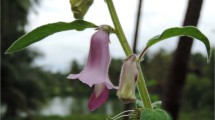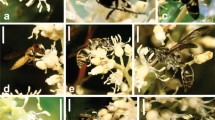Abstract
The effect of nectar robbing on plant fitness is poorly understood and restricted to a few plant species. Furthermore, the available studies generally evaluate the effects of nectar robbing on female fitness, disregarding the male component. Here we measured the effects of the nectar-robbing bumblebees on male (measured as pollen analogue flow distance) and female (measured as seed production) reproductive success in the insect-dependent Polygala vayredae, a narrow endemic species from the pre-Pyrenees (Spain). Intense nectar robbing by bumblebees significantly reduced the nectar available to legitimate pollinators in the studied population, and this reduction affected both male and female fitness. Significant differences were observed in fluorescent dye dispersion between robbed and non-robbed flowers within the population. Fluorescent dyes from non-robbed flowers were dispersed to larger distances and over a larger number of flowers when compared with robbed ones. Moreover, significant differences were observed in both fruit set and seed ovule ratios between the two groups, with non-robbed flowers presenting higher reproductive outcomes. However, no effect on seed weight was detected among treatments. The data obtained suggest that in this species, nectar robbing has important indirect and negative effects on plant fecundity, through both male and female functions, due to a modification in the foraging behaviour of legitimate visitors.

Similar content being viewed by others
References
Adler LS, Irwin RE (2006) Comparison of pollen transfer dynamics by multiple floral visitors: experiments with pollen and fluorescent dye. Ann Bot 97:141–150
Arizmendi M, Domínguez C, Dirzo R (1996) The role of an avian nectar robber and of hummingbird pollinators in the reproduction of two plant species. Funct Ecol 10:119–127
Castro S (2007) Reproductive biology and conservation of the endemic Polygala vayredae. PhD Thesis, University of Aveiro, Portugal
Castro S, Silveira P, Navarro L (2008a) Floral traits variation, legitimate pollination and nectar robbing in Polygala vayredae (Polygalaceae). Ecol Res. doi:10.1007/s11284-008-0481-5
Castro S, Silveira P, Navarro L (2008b) How flower biology and breeding system affect the reproductive success of the narrow endemic Polygala vayredae Costa (Polygalaceae)? Bot J Linn Soc 157:67–81
Castro S, Silveira P, Navarro L (2008c) How does secondary pollen presentation affect the fitness of Polygala vayredae (Polygalaceae)? Am J Bot. doi:10.3732/ajb.2007329
Charnov EL (1976) Optimal foraging: marginal value theorem. Theor Popul Biol 9:129–136
Fritz RS, Morse DH (1981) Nectar parasitism of Asclepias syriaca by ants: effect on nectar levels, pollinia insertion, pollinaria removal and pod production. Oecologia 50:316–319
González-Gómez PL, Valdivia CE (2005) Direct and indirect effects of nectar robbing on the pollinating behavior of Patagona gigas (Trochilidae). Biotropica 37:693–696
Goulson D, Hawson SA, Stout JC (1998) Foraging bumblebees avoid flowers already visited by conspecifics or by other bumblebee species. Anim Behav 55:199–206
Higashi S, Ohara M, Arai H, Matsuo K (1988) Robber-like pollinators: overwintered queen bumblebees foraging on Corydalis ambigua. Ecol Entomol 13:411–418
Hodges CM (1985) Bumble bee foraging: the threshold departure rule. Ecology 66:179–187
Inouye DW (1980) The terminology of floral larceny. Ecology 61:1251–1253
Inouye DW (1983) The ecology of nectar robbing. In: Bentley B, Elias T (eds) The biology of nectaries. Columbia University Press, New York
Irwin RE, Brody AK (1998) Nectar robbing in Ipomopsis aggregata: effects on pollinator behavior and plant fitness. Oecologia 116:519–527
Irwin RE, Brody AK (1999) Nectar-robbing bumble bees reduce the fitness of Ipomopsis aggregata (Polemoniaceae). Ecology 80:1703–1712
Irwin RE, Brody AK (2000) Consequences of nectar robbing for realized male function in a hummingbird-pollinated plant. Ecology 81:2637–2643
Irwin RE, Brody AK, Waser NM (2001) The impact of floral larceny on individuals, populations, and communities. Oecologia 129:161–168
Klinkhamer PGL, de Jong TJ (1993) Attractiveness to pollinators: a plant’s dilemma. Oikos 66:180–184
Maloof JE (2001) The effects of a bumble bee nectar robber on plant reproductive success and pollinator behavior. Am J Bot 88:1960–1965
Maloof JE, Inouye DW (2000) Are nectar robbers cheaters or mutualists? Ecology 81:2651–2661
Morris WF (1996) Mutualism denied? Nectar-robbing bumble bees do not reduce female or male success of bluebells. Ecology 77:1451–1462
Navarro L (1999) Pollination ecology and effect of nectar removal in Macleania bullata (Ericaceae). Biotropica 31:618–625
Navarro L (2000) Pollination ecology of Anthyllis vulneraria subsp. vulgaris (Fabaceae): nectar robbers as pollinators. Am J Bot 87:980–985
Navarro L (2001) Reproductive biology and effect of nectar robbing on fruit production in Macleania bullata (Ericaceae). Plant Ecol 152:59–65
Navarro L, Guitián J, Guitián P (1993) Reproductive biology of Petrocoptis grandiflora Rothm (Caryophyllaceae), a species endemic to Northwest Iberian Peninsula. Flora 188:253–261
Ornelas JF, Ordano M, Lara C (2007) Nectar removal effects on seed production in Moussonia deppeana (Gesneriaceae), a hummingbird-pollinated shrub. Ecoscience 14:117–123
Prys-Jones O, Corbet S (1987) Bumblebees. Cambridge University Press, Cambridge
Pyke GH (1978) Optimal foraging: movement patterns of bumblebees between inflorescences. Theor Popul Biol 13:72–98
Pyke GH (1991) What does it cost a plant to produce floral nectar. Nature 350:58–59
Rademaker MCJ, deJong TJ, Klinkhamer PGL (1997) Pollen dynamics of bumblebee visitation on Echium vulgare. Funct Ecol 11:554–563
Reddy TB, Rangaiah K, Reddi EUB, Reddi CS (1992) Consequences of nectar robbing in the pollination ecology of Vitex negundo (Verbenaceae). Curr Sci 62:690–691
Roubik DW (1978) Competitive interactions between neotropical pollinators and Africanized honey bees. Science 201:1030–1032
Roubik DW (1982) The ecological impact of nectar-robbing bees and pollinating hummingbirds on a tropical shrub. Ecology 63:354–360
Roubik DW, Holbrook NM, Parra G (1985) Roles of nectar robbers in reproduction of the tropical treelet Quassia amara (Simaroubaceae). Oecologia 66:161–167
Southwick EE (1984) Photosynthate allocation to floral nectar: a neglected energy investment. Ecology 65:1775–1779
Stout JC, Allen JA, Goulson D (2000) Nectar robbing, forager efficiency and seed set: bumblebees foraging on the self incompatible plant Linaria vulgaris (Scrophulariaceae). Acta Oecol 21:277–283
Thomson JD, Plowright RC (1980) Pollen carryover, nectar rewards, and pollinator behavior with special reference to Diervilla lonicera. Oecologia 46:68–74
Thomson JD, Price MV, Waser NM, Stratton DA (1986) Comparative studies of pollen and fluorescent dye transport by bumblebees visiting Erythronium grandiflorum. Oecologia 69:561–566
Traveset A, Willson MF, Sabag C (1998) Effect of nectar-robbing birds on fruit set of Fuchsia magellanica in Tierra del Fuego: a disrupted mutualism. Funct Ecol 12:459–464
VV.AA. (2000) Lista Roja de Flora Vascular Española (valoración según categorías UICN). Conservación Vegetal 6:11–36
Waser NM (1988) Comparative pollen and dye transfer by pollinators of Delphinium nelsonii. Funct Ecol 1:41–48
Waser NM, Price MV (1982) A comparison of pollen and fluorescent dye carryover by natural pollinators of Ipomopsis aggregata (Polemoniaceae). Ecology 63:1168–1172
Wyatt R (1980) The impact of nectar-robbing ants on the pollination system of Asclepias curassavica. Bull Torrey Bot Club 107:24–28
Young HJ, Stanton ML (1990) Influences of floral variation on pollen removal and seed production in wild radish. Ecology 71:536–547
Zar JH (1984) Biostatistical analysis. Prentice-Hall, Inc., New Jersey
Zhang YW, Robert G, Wang Y, Guo YH (2007) Nectar robbing of a carpenter bee and its effects on the reproductive fitness of Glechoma longituba (Lamiaceae). Plant Ecol 193:1–13
Zimmerman M, Cook S (1985) Pollinator foraging, experimental nectar-robbing and plant fitness in Impatiens capensis. Am Midl Nat 113:84–91
Acknowledgements
The authors thank the Departamento de Medi Ambient of Generalitat de Cataluña and the Consorsi d’Alta Garrotxa for allowing this research and the Parc Natural de la Zona Volcànica de la Garrotxa for all the assistance. The authors also thank João Loureiro and colleagues on the project CYTED 2003-XII-6 for critical reading of the manuscript. The Portuguese Foundation for Science and Technology financed the work of Sílvia Castro (FCT/BD/10901/2002). The work was also partially financed under grants to Luis Navarro, PGIDT04PXIC31003PN from the Xunta de Galicia and CGL2006-13847-CO2-02 from the Spanish DGICYT.
Author information
Authors and Affiliations
Corresponding author
Rights and permissions
About this article
Cite this article
Castro, S., Silveira, P. & Navarro, L. Consequences of nectar robbing for the fitness of a threatened plant species. Plant Ecol 199, 201–208 (2008). https://doi.org/10.1007/s11258-008-9424-z
Received:
Accepted:
Published:
Issue Date:
DOI: https://doi.org/10.1007/s11258-008-9424-z




